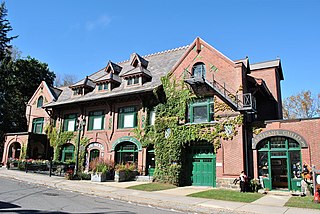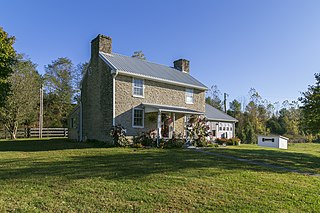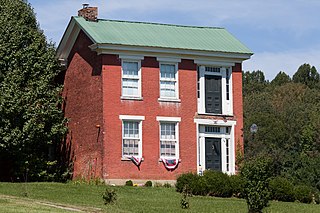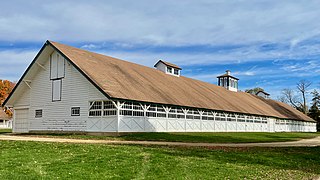
Norfolk is a town in Litchfield County, Connecticut, United States. The population was 1,588 at the 2020 census. The town is part of the Northwest Hills Planning Region. The urban center of the town is the Norfolk census-designated place, with a population of 553 at the 2010 census.

The Stonington Harbor Light is a historic lighthouse built in 1840 and located on the east side of Stonington Harbor in the Borough of Stonington, Connecticut. It is a well-preserved example of a mid-19th century stone lighthouse. The light was taken out of service in 1889 and now serves as a local history museum. It was listed on the National Register of Historic Places in 1976.

The Grave Creek Mound in the Ohio River Valley in West Virginia is one of the largest conical-type burial mounds in the United States, now standing 62 feet (19 m) high and 240 feet (73 m) in diameter. The builders of the site, members of the Adena culture, moved more than 60,000 tons of dirt to create it about 250–150 BC.

Buffalo City Hall is the seat for municipal government in the City of Buffalo, New York. Located at 65 Niagara Square, the 32-story Art Deco building was completed in 1931 by Dietel, Wade & Jones.

Liberty Hall is a historic house museum at 218 Wilkinson Street in Frankfort, Kentucky. Built 1796-1800 by American statesman John Brown, it was designated in 1971 as a U.S. National Historic Landmark for its association with Brown and its fine Federal-style architecture.

Augusta Stone Church is a Presbyterian (PCUSA) place of worship located in Augusta County in the Commonwealth of Virginia, USA in the unincorporated community of Fort Defiance. The church was one of two meeting houses established by The Congregation of the Triple Forks of the Shenandoah in the year 1740. Augusta Stone and the sister meeting house Tinkling Spring were both served by the Rev. John Craig. The final structure which was completed in 1749 is still in use and holds the distinction of being the oldest Presbyterian Church in continuous use in Virginia.

The Salem Downtown Historic District is a national historic district located at Salem, Washington County, Indiana. The original plat of the town, founded in 1814, is within the district. It is bounded by Mulberry and Hackberry Street in the north, Hayes Street in the east, the CSX railroad tracks in the south, and Brock Creek to the west. It encompasses 253 contributing buildings, 3 contributing structures, and 5 contributing objects in the central business district of Salem. The district was placed on the National Register of Historic Places in 1997. Its architectural styles are Italianate, Gothic Revival, Classical Revival, Late Victorian, Early Republic, and Late 19th/20th Century Revivals.

The Corydon Historic District is a national historic district located in Corydon, Indiana, United States. The town of Corydon is also known as Indiana's First State Capital and as Historic Corydon. The district was added to the National Register of Historic Places in 1973, but the listing was amended in 1988 to expand the district's geographical boundaries and include additional sites. The district includes numerous historical structures, most notably the Old Capitol, the Old Treasury Building, Governor Hendricks' Headquarters, the Constitution Elm Memorial, the Posey House, the Kintner-McGrain House, and The Kintner House Inn, as well as other residential and commercial sites.

The Fryer House is located in Butler, Kentucky. This historic two-story stone house was built by Pendleton County, Kentucky pioneer Walter Fryer in 1811. Abraham Vastine, a housebuilder, built this house of limestone from an adjacent quarry, and it has walls two feet thick. The roof truss system is built of wood framing held together with wooden pegs. The home was not completed until 1813.

Pewee Valley Confederate Cemetery is one mile from the old Kentucky Confederate Home site. The National Register of Historic Places lists the cemetery and separately an individual monument within it, the Confederate Memorial in Pewee Valley, as part of the Civil War Monuments of Kentucky MPS. It is the only cemetery for Confederate veterans, 313 in total, that is an official state burying ground in Kentucky.

The Battle of Tebb's Bend Monument in Taylor County, Kentucky, near Campbellsville, Kentucky, commemorates the Battle of Tebbs Bend, which occurred on July 4, 1863, during the Civil War. The battle was essentially a Union victory, as it greatly delayed John Hunt Morgan's famous Raid that would later go into Indiana and Ohio.

The Confederate Monument in Danville, originally located between Centre College and the First Presbyterian Church at the corner of Main and College Streets in Danville, Kentucky, was a monument dedicated to the Confederate States of America that is on the National Register of Historic Places. The monument was dedicated in 1910 by the surviving veterans of the Confederacy of Boyle County, Kentucky and the Kate Morrison Breckinridge Chapter of the United Daughters of the Confederacy (UDC). In 2021, it was relocated to a museum in Meade County, Kentucky.

The Baltimore and Ohio Ellicott City Station Museum in Ellicott City, Maryland, is the oldest remaining passenger railway station in the United States, and one of the oldest in the world. It was built in 1830 as the terminus of the Baltimore and Ohio Railroad line from Baltimore to the town then called Ellicott's Mills, and a facility to service steam locomotives at the end of the 13-mile (21 km) run. The station, a National Historic Landmark, is now used as a museum.

San Estévan del Rey Mission Church is a Spanish mission church in the Roman Catholic Diocese of Gallupon the Acoma Pueblo Reservation in western New Mexico. Built between 1629 and 1641, it is one of the finest extant examples of hybrid Spanish Colonial and Puebloan architectural styles. It was named for Saint Stephen I of Hungary. The church was declared a National Historic Landmark in 1970, and is listed on the National Register of Historic Places. It remains a mission church and is part of the parish of San José de la Laguna in Laguna, New Mexico.

Burrages End is a historic home near Lothian, Anne Arundel County, Maryland, United States. It is a small 1+1⁄2-story frame house with gambrel roof. The site is noteworthy for containing a number of buildings from the late 18th century or early 19th century. The house was constructed c. 1780, replacing an earlier house on the site, according to a 1982 study by the Architectural Research Department of the Colonial Williamsburg Foundation, presumably by Col. John Weems who purchased the property in 1764. Weems was the construction contractor for the 1762-65 St. James' Church 3/4 mile to the south. At Weems' death in 1794, Burrages End was sold to Thomas Sellman and remained in that family's hands until 1946. A Weems-Sellman cemetery is on site.

George Pinkney Morgan House, also known as David Morgan Homeplace, is a historic home located at Rivesville, Marion County, West Virginia. It was built between 1857 and 1860, and is a two-story, red brick farmhouse in the Greek Revival style.
The Civil War Trust's Civil War Discovery Trail is a heritage tourism program that links more than 600 U.S. Civil War sites in more than 30 states. The program is one of the White House Millennium Council's sixteen flagship National Millennium Trails. Sites on the trail include battlefields, museums, historic sites, forts and cemeteries.

Old Courthouse, also known as the Second St. Joseph County Courthouse, is a historic courthouse located at South Bend, St. Joseph County, Indiana. It was designed by architect John M. Van Osdel (1811-1891) and built in 1853. It is a two-story, Greek Revival style stone building. The building measures 61 feet wide and 93 feet deep. It features a projecting front portico supported by Doric order columns and a front gable roof topped by a cupola. It was moved to its present site in 1896. Following construction of the Third St. Joseph County Courthouse, the building housed the local G.A.R. chapter and historical museum. The building now houses office of the Traffic and Misdemeanor Court and Small Claims Court.
The Thomas Dawson House, in Trigg County, Kentucky about 12 miles (19 km) south of Cadiz, was built in 1816–17. It was listed on the National Register of Historic Places in 1980.

Brookdale Farm is a former Thoroughbred breeding and training farm located at 805 Newman Springs Road in the Lincroft section of Middletown Township in Monmouth County, New Jersey. Thomas Lloyd acquired the property in the late 18th century. In 1872, David Dunham Withers established the horse breeding and training operation. By 1889, the farm included 838 acres (3.39 km2). In 1968, 215 acres (0.87 km2) of the farm were bequeathed by Geraldine Morgan Thompson to the county to create Thompson Park.



















